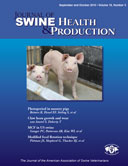Abstract:

Influence of photoperiod on the behavior and performance of newly weaned pigs with a focus on time spent at the feeder, feed disappearance, and growth
Kerstin Reiners, MSc; Engel F. Hessel, PD Dr; S. Sieling, MSc; Herman F. A. Van den Weghe, Prof Dr Ir
Complete article is available online.
PDF version is available online.
Objective: To evaluate whether a prolonged photoperiod days 1 to 4 after weaning influences behavior and performance.
Materials and methods: Weaned pigs were allotted to daily photoperiods of 20 hours and 8 hours of light, respectively, for days 1 to 4 after weaning. Data were obtained from 234 pigs from 12 pens, resulting in n = 6 replicates per treatment. Behavior was observed during the initial 48 hours after weaning and on day 5 (when photoperiod was changed from 20 hours to 8 hours) in the prolonged light exposure group. Feed disappearance was recorded throughout the whole nursery period. Pigs were individually weighed on the day of weaning and at weekly intervals during the 7-week nursery period.
Results: Feed disappearance tended to be higher (P = .09) in the prolonged light exposure group in the initial 24 hours after weaning. Considering the whole nursery period, feed disappearance did not differ between the treatment groups (P = .73). Pigs in the prolonged light exposure group did not gain more weight in the first week after weaning (P = .34). Also considering the entire 7-week nursery period, body weight gain did not differ between the groups (P = .84).
Implications: Feed disappearance on the day after weaning tends to be greater in pigs housed in a prolonged photoperiod. Nevertheless, prolonging the photoperiod during the first 4 days after weaning does not influence feed disappearance or body weight gain over the entire nursery phase.
Keywords: time spent at the feeder, performance, photoperiod, weaning
![]() Cite as: Reiners K, Hessel EF, Sieling S, et al. Influence of photoperiod on the behavior and performance of newly weaned pigs with a focus on time spent at the feeder, feed disappearance, and growth. J Swine Health Prod 2010;18(5):230-238.
Cite as: Reiners K, Hessel EF, Sieling S, et al. Influence of photoperiod on the behavior and performance of newly weaned pigs with a focus on time spent at the feeder, feed disappearance, and growth. J Swine Health Prod 2010;18(5):230-238.
Search the AASV web site for pages with similar keywords.
